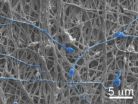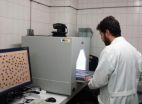(Press-News.org) The only way to protect against HIV and unintended pregnancy today is the condom. It's an effective technology, but not appropriate or popular in all situations.
A University of Washington team has developed a versatile platform to simultaneously offer contraception and prevent HIV. Electrically spun cloth with nanometer-sized fibers can dissolve to release drugs, providing a platform for cheap, discrete and reversible protection.
The research was published this week in the Public Library of Science's open-access journal PLoS One. The Bill & Melinda Gates Foundation last month awarded the UW researchers almost $1 million to pursue the technology.
"Our dream is to create a product women can use to protect themselves from HIV infection and unintended pregnancy," said corresponding author Kim Woodrow, a UW assistant professor of bioengineering. "We have the drugs to do that. It's really about delivering them in a way that makes them more potent, and allows a woman to want to use it."
Electrospinning uses an electric field to catapult a charged fluid jet through air to create very fine, nanometer-scale fibers. The fibers can be manipulated to control the material's solubility, strength and even geometry. Because of this versatility, fibers may be better at delivering medicine than existing technologies such as gels, tablets or pills. No high temperatures are involved, so the method is suitable for heat-sensitive molecules. The fabric can also incorporate large molecules, such as proteins and antibodies, that are hard to deliver through other methods.
At a lab meeting last year, Woodrow presented the concept, and co-authors Emily Krogstad and Cameron Ball, both first-year graduate students, pursued the idea.
They first dissolved polymers approved by the Food and Drug Administration and antiretroviral drugs used to treat HIV to create a gooey solution that passes through a syringe. As the stream encounters the electric field it stretches to create thin fibers measuring 100 to several thousand nanometers that whip through the air and eventually stick to a collecting plate (one nanometer is about one 25-millionth of an inch). The final material is a stretchy fabric that can physically block sperm or release chemical contraceptives and antivirals.
"This method allows controlled release of multiple compounds," Ball said. "We were able to tune the fibers to have different release properties."
One of the fabrics they made dissolves within minutes, potentially offering users immediate, discrete protection against unwanted pregnancy and sexually transmitted diseases.
Another dissolves gradually over a few days, providing an option for sustained delivery, more like the birth-control pill, to provide contraception and guard against HIV.
The fabric could incorporate many fibers to guard against many different sexually transmitted infections, or include more than one anti-HIV drug to protect against drug-resistant strains (and discourage drug-resistant strains from emerging). Mixed fibers could be designed to release drugs at different times to increase their potency, like the prime-boost method used in vaccines.
The electrospun cloth could be inserted directly in the body or be used as a coating on vaginal rings or other products.
Electrospinning has existed for decades, but it's only recently been automated to make it practical for applications such as filtration and tissue engineering.
This is the first study to use nanofibers for vaginal drug delivery.
While this technology is more discrete than a condom, and potentially more versatile than pills or plastic or rubber devices, researchers say there is no single right answer.
"At the time of sex, are people going to actually use it? That's where having multiple options really comes into play," Krogstad said. "Depending on cultural background and personal preferences, certain populations may differ in terms of what form of technology makes the most sense for them."
The team is focusing on places like Africa where HIV is most common, but the technology could be used in the U.S. or other countries to offer birth control while also preventing one or more sexually transmitted diseases.
The research to date was funded by the National Institutes of Health and the UW's Center for AIDS Research. The other co-author on the paper is Thanyanan Chaowanachan, a UW postdoctoral researcher and longtime HIV expert.
The team will use the new Gates Foundation grant to evaluate the versatility and feasibility of their system. The group will hire more research staff and buy an electrospinning machine to make butcher-paper sized sheets. The expanded team will spend a year testing combinations that deliver two antiretroviral drugs used to treat HIV and a hormonal contraceptive, and then six months scaling up production of the most promising materials.
INFORMATION:
For more information, contact Woodrow at 206-685-6831 or woodrow@uw.edu.
Electrically spun fabric offers dual defense against pregnancy, HIV
2012-11-30
ELSE PRESS RELEASES FROM THIS DATE:
When eating for 2 becomes a weighty issue
2012-11-30
Two-thirds of Australian mums-to-be are in the dark when it comes to how much weight they should gain during pregnancy.
Susie de Jersey from Queensland University of Technology's (QUT) Institute of Health and Biomedical Innovation (IHBI) and senior dietician at the Royal Brisbane and Women's Hospital said a third of women surveyed gained too much weight during pregnancy. Another third struggled to gain enough weight with some mothers recording a lower weight just before giving birth than they did before falling pregnant.
"The majority of the women in the study knew ...
The colour of love: Zebrafish perform colorful courtship displays
2012-11-30
Elaborate secondary sexual displays are often overlooked because many species attract mates through sensory modalities imperceptible to humans, including ultraviolet light, ultrasound, electrical signals, or pheromones. Also, sexual coloration may only be expressed briefly during courtship (ephemeral courtship dichromatisms) to avoid attracting predators. Zebrafish (Danio rerio) are a widely studied model organism, though there have been few studies on their mating behaviour. Like many schooling fish, zebrafish do not appear sexually dichromatic to humans; there are no ...
Help for European children to resist unhealthy temptations
2012-11-30
Children and young people in Europe are exposed to all kinds of fast food, crisps and fizzy drinks – so how can they learn to resist the temptation to indulge?
This is the question that the European research project TEMPEST was set up to answer. The research project involves researchers from nine European countries and one of the team members is Liliya Nureeva, a PhD student at Aarhus University.
The TEMPEST research project has prepared strategies for children to use to suppress or control their desire to scoff sweets and snacks. One of the main objectives of the ...
Clearest evidence yet of polar ice losses
2012-11-30
After two decades of satellite observations, an international team of experts brought together by ESA and NASA has produced the most accurate assessment of ice losses from Antarctica and Greenland to date. This study finds that the combined rate of ice sheet melting is increasing.
The new research shows that melting of the Antarctic and Greenland ice sheets has added 11.1 mm to global sea levels since 1992. This amounts to about 20% of all sea-level rise over the survey period.
About two thirds of the ice loss was from Greenland, and the remainder was from Antarctica. ...
New study finds what makes a good mentor and mentee
2012-11-30
TORONTO, Nov. 30, 2012—How-to books are full of advice on what makes a good mentor. But what makes a good mentee and what chemistry is needed to make the relationship work?
People being mentored should be open to feedback and be active listeners, according to a new research paper. They should also be respectful of their mentor's time, including being on time and prepared for meetings.
And it helps to follow at least some of their advice.
"Successful mentorship is vital to career success and satisfaction for both mentors and mentees," said Dr. Sharon Straus, a researcher ...
Biomarker progress offers hope for early autism spectrum disorder detection
2012-11-30
Amsterdam, NL, November 30, 2012 – Autism spectrum disorders (ASD) are neurodevelopmental disorders typically characterized by difficulties in social interactions and delayed or abnormal language development. Although ASD reportedly affects 1 in 88 people in the United States, to date there have been no distinctive biomarkers to diagnose the disease. In a special themed issue of Disease Markers, investigators report on the current understanding of ASD genetics and the possibilities of translating genetic research toward biomarker development in ASD.
"Although some individuals ...
Gulf of Mexico clean-up makes 2010 spill 52-times more toxic
2012-11-30
If the 4.9 million barrels of oil that spilled into the Gulf of Mexico during the 2010 Deep Water Horizon spill was a ecological disaster, the two million gallons of dispersant used to clean it up apparently made it even worse – 52-times more toxic. That's according to new research from the Georgia Institute of Technology and Universidad Autonoma de Aguascalientes (UAA), Mexico.
The study found that mixing the dispersant with oil increased toxicity of the mixture up to 52-fold over the oil alone. In toxicity tests in the lab, the mixture's effects increased mortality ...
How native plants and exotics coexist
2012-11-30
ROCK HILL, S.C. - When people hear about exotic plants invading a new environment, there is usually a negative connotation. They often think of plants like kudzu, Chinese privet, or Japanese honeysuckle, whose thuggish behavior can push out the native plants in their backyard or local parks.
While this worse case scenario can happen, it isn't always the case, according to ecologists at Winthrop University and Brown University in an article published in the journal Ecology Letters.
"Basically, we found that exotics plants grow more and can essentially out-compete natives, ...
Hospital cleaning protocol ineffective against A. baumannii
2012-11-30
Washington, November 30, 2012 -- Current hospital cleaning protocol may be inadequate to rid patient rooms of multidrug-resistant (MDR) Acinetobacter baumannii, according to a study in the December issue of the American Journal of Infection Control, the official publication of the Association for Professionals in Infection Control and Epidemiology (APIC).
A team of researchers from the University of Maryland collected 487 cultures from 32 hospital rooms occupied by just-discharged patients with a known history of MDR A. baumannii both before and after terminal cleaning ...
A digital portrait for grapes indicates their ripeness
2012-11-30
Researchers at the University of Seville (Spain) have developed a technique for estimating grape composition and variety using computer imaging. They have also put forward an index for identifying the ripeness of seeds without the need for chemical analysis. This new method can help to decide the best moment for picking.
The normal procedure for identifying the sugar content of grapes involves chemical analysis. But this is a long and tedious task that tells vine-growers when to start picking their grapes. Now though, scientists at the University of Seville (US) are proposing ...


